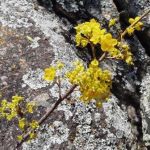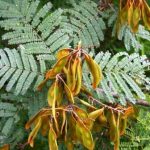TREE LIFE
February 1993
MASHONALAND CALENDAR
Tuesday 2nd February : Botanic Garden Wall: at 1645 hours for 1700 hours. Park at the Herbarium where we will meet Tom Muller for part II of Combretaceae.
Sunday 21st February : Msasa Farm in the Barwick area. Our hosts, David and Lorna Coleman and family have several interesting Kopjies next to one of their dams. Some bushman paintings and a ruined fort? should be worth a visit.
Saturddy 27th February: Mark knows of an interesting spot for this walk, near the Italian Club in Mabelreign. From town westward along Samora. Machel Ave, right into Drummond Chaplin which becomes West Road, turn left into Quendon road. We will meet at 3 pm, 0.5 km beyond the Italian Club under the pepper trees which line the road. If per chance the mowers have been active there are other equally interesting spots close by.
Tuesday 2nd March : Botanic Garden Walk
MATABELELAND CALENDAR
Sunday 7th February : Quiet Waters. An all day outing. Rendezvous at the Ascot car park for an 0830 hours departure
Monday 8th February : Urban Trails. Meet at Hillside Dams at 1645 hours for 1700 hours
Sunday 7th March : Amalinda. Dave and Linda Bennet. Meet at Retreat for an 0800 hours departure. A morning or all day outing depending on the individual.
Monday 8th March : Urban Trails. Meet at Hillside Dams at 1645 hours for 1700 hours
BOTANIC GARDEN WALK on 5th January 1993
This day Thom Muller spoke to us about COMBRETACEAE, all now madly in leaf. The family is valuable for use as ecological indicator plants. As one moves across country and species change, so does the local environment. Another practical use is to be found in the fact that because of the unique scale pattern on the leaf lamina, identification of such through the microscope means that even a small leaf fragment may be used to identify the species, and this is very useful in mammal feeding studies.
Combretum is very often one of the first trees we learn because of the distinct seed pod : “Daddy, there is this tree in our school playground and we call it funny helicopters”. (This of course where Monotes glaber is not also in the school grounds).
Combretum molle seems to grow everywhere in the country.
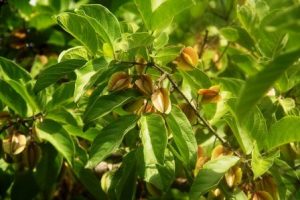
Combretum apiculatum.
Photo: Bart Wursten. Source: Flora of Zimbabwe
Combretum apiculatum does have a more restricted range, but numerically it may be the
most frequent tree.
Combretum zeyheri is normally easy to identity, at least when the large fruit is found.
So we think we know the genus and also the rather similar Terminalia. At least I thought I had a good idea. Until, that is, I followed Mr Muller around the Botanic Garden and I realised just how little I knew about this family.
All right so I admit to stupidity and get confused over what must be a really very simple difference in twig bark in Terminalia, but it is a shock to learn what I have been greeting in the bush as T.stenostachya is in fact T.trichopoda, or maybe a hybrid between the latter and T.sericea.
It is little consolation to learn from history that ones olders and betters, the men of the 1896 column, as they moved through the Mangwe Pass, were equally confused when they identified T.sericea with the famous Silver Tree, Leucodendron argenteum, from the Cape. For this reason one of its common names is listed as Mangwe Tree.
Looking through my notes, I see I recorded Thom as indicating the range of T.trichopoda as “from Hatfield to the Zambezi Valley”. It occurs to me what a wonderful title this would make for a movie (bioscope to readers of my generation). Think about “Out of Africa from Hatfield to the Zambezi” or again “on a clear day here you can see from Hatfield to . . . . .”
To me perhaps the really interesting Terminalias are T.prunioides and T.randii. They take me back forty years to when I used to wander round the Shashi area in Southern Matabeleland. There was this amazing smell, and it took me years to find out it was the rather delightful scent of the spring blossoms of one of these two. For a long time, stupid it may now sound, I was side tracked into looking for an insect, having learnt the Matabele ant smell.
So all this shows how interesting is COMBRETACEAE and also just how little I have learnt over the years. If you would like to know more, come and join us at the Botanic Garden on the February jaunt when we will have the second part.
-G.HALL
VISIT TO VENTERSBERG FARM 17 January 1993
Ventersburg Farm is only 15.5 km from Harare and we picked this nearby venue as at this time of year there is the distinct possibility of being rained out. A couple of us had recently done a ‘recce’ to the farm and we fully realized that the area was common Harare woodland and did not hold any startling or rare species for us, but as mentioned the rain factor kept us from venturing further afield to more exciting spots. However no matter how common the flora, a walk at this time of year amongst brachystegia/julbernadia full of lush green foliage was good for the soul.
We were worried about the weather but when we gathered on Sunday morning The Great Architect favoured us with a perfect day. We parked under a splendid shady grove of Musasa/Mnondos and our host, Dave Berger had kindly taken the trouble to mow the grass so we had a perfect pastoral setting with the smell of new mown hay and on each side of us were lush pastures inhabited by fat sleek Charolais cattle lowing contentedly, all we needed was Beethoven’s 6th playing in the back ground to boost our “jois de vivre”.
Our special guest that morning was Stephen Mavi who works at the National Herbarium and who is well versed on the medicinal properties and spiritual/folklore uses of our flora as practised and used by the indigenous people of this country. We started off with a short walk through the pastures before we reached the veld and the first tree encountered was the ubiquitous Syringa; and Stephen pointed out that an infusion of the bark and roots provides a good antibiotic mainly used to cure venereal diseases but stressed that wrong proportion can be poisonous especially the berries. Reminds me of an anecdote about a sickly child that cost its parents a fortune taking it to specialists in Johannesburg regularly to try and cure the mysterious illness. However when in Johannesburg the symptoms always disappeared, the answer was eventually discovered, older brother and sister were feeding it Syringe berries! It was mentioned that Cassia abbreviata is also widely used as an anti- biotic, at least it can’t smell worse than the Mediterranean antibiotic, garlic.
Stephen stopped by one of the first Brachystegia spiciformis and gave us a few theories regarding the derivation of the local name “Musasa” which literally translated means “place of the camp” as the shade of these trees was invariably used as a resting place. “Mnondo” was from the word nondo which is the sound made by the clapping of hands in greeting, similar to the sound of the pods exploding. Some other theories, nondo is the name for the Tsessebe and they often graze/rest under this tree, or nondo is another name for the chess type game Tsoro which is often played in the shade of the Mnondo. The Musasa is valued for other reasons, it makes good firewood, the bark is used for utensils and rope, tannin is also extracted from the bark for curing hides and at certain times of year the tree is infested with nutritious caterpillars called “sinnini”. An infusion of the bark or root, soaked, not boiled makes an effective remedy for upset stomachs.
We came across, Lopholaena coriifolia, the noxious weed which suggests overgrazing in previous years, nearby Eriosema sp. which is a legume and trailing amongst it Dicerocaryum senecioides with its pretty mauve to pink flower. Stephen called this latter plant the boot protector as the thorns look like boot studs, some call it devil thorn, Shona name is ‘ruredzo’, the plant can be used as a substitute for soap or shampoo as when crushed and mixed with water makes a soapy glutinous mixture similar to the texture of cooked ochre, the leaves can be used as spinach.
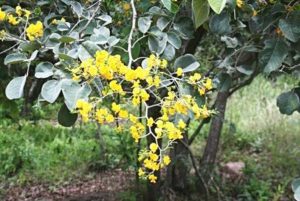
Pterocarpus rotundifolias. Photo: Mark Hyde. Source: Flora of Zimbabwe
There was definately a lack of colour in the veld, the only things contrasting with the mass of green were the already mentioned flowers of the Dicerocaryum, the odd Gloriosa supeba and one lonely but majestic Pterocarpus rotundifolias still with its striking yellow plumage, it stood out amongst the surrounding bush like a lighthouse. On encountering Grudiakraussiana we learnt that this is poisonous to cattle and the root stock used as a fish poison, the fish thus caught are not harmful to humans as the fish actually die from some substance in the plant which clogs the gills and suffocates the fish, Shona name ‘chitupatupa’. As we passed Vitex payos Stephen advised that this was good for asthma, inhaling the smoke from the dried burnt leaves, most of us know this as the chocolate berry, interestingly Coates Palgrave mentions it lacks Vit C, well they say chocolates aren’t good for you! Another tip which will interest Boy Scouts, the dry twigs rubbed together are good fire makers “a la cave man style”.
A Securidaca logipedunculata was found pushed right over and some of the root removed, an infusion of this is similar to wintergreen and is good for the sinuses, sadly however its other common use is for abortions and suicides, often the deaths not being intentional as a slight overdose proves fatal in the case of attempted abortion.
We did eventually find a bit more colour in the red fruit of Psorospermum febrifugum (Christmas berry): and a lone Dichrostacys cinerea with its yellow and pink puffs. We discovered that many locals avoid Psorospermum and dare not touch it as it is supposedly connected with witches, Shana name “Mupaaaradzamusha”, some brave types do however make a potion powder from it and throw it in a fire in order to cause a divorce amongst a chosen couple.
In a Monotes glaber were lots of yellow and black beetles somebody called them CMR or Cape Mounted Rifle jobs, some thing to do with similar regimental colours. A Vangueriopsis next hearing a single ripe fruit which Stephen picked and ate with extreme alacrity swing that he has a number of them near his home and has not seen them fruiting for years, he also mentioned that the fruit of Sysygium cordatum is also delicious, cordatum hybridises freely with guincense. In passing an Ozoroa insignis we were told the bark is used as an aphrodisiac and on the subject of barks Stephen told us that ngangas or herbalists only collect from either the west or the east side of a tree, reason unknown, and an nganga will never take a piece from a tree that has already been collected from by another nganga for fear of contamination from the previous collector.
We wondered a little further and came to the ugly sore in the landscape that our host Dave had very strong feelings about. It was a 25 metre wide swathe that had been bulldozed through the veld 208 km long and every tree and shrub in this unnecessarily wide track destroyed, all to accommodate a mere 5OOmm (l2″) pipe to carry fuel from Mutare to Harare. If this type of environmental destruction had occurred overseas there would have been a national outcry. The pipeline has been completed and the contractors have gone, hopefully the good rains will assist nature to speedily cover up this unsightly gash in the countryside‘.
The end of the woodland was reached and we started to wander down open vlei towards a granite outcrop with a small seasonal stream running through it. This picturesque area seemed to have its own distinct mini eco system, we found Protea gaguedi, Allophylus africanum, Grewia monticola, and right in the middle of the stream getting its feet wet was Sysygium cordatum.
On the other side of the stream Fiona stumbled on a beautiful flowering Grewia stolzii, also we found Flacourtia indica and a distinctive trunk was a give away clue to beginners like me for Ochna pulchra.
By this time my brain had become somewhat addled and super saturated with botanical names and for the fun of it I will quote from my note book the jumble of hastily written misspelt species we also encountered: –Glabrum, rhamnus? Ficus thonningii, Pterocarpus angolensis, Albizia antunisia, Diospiros licyoides, Clerodendrum, Myra cussonia aborea, brakalena, Dovyalis zeylii, Celtis africarna, Paveta, Loranthus, plus loads of viscum!!!!
Tummies were starting to rumble so we started to circle back to the parking area where refreshment awaited us hot thirsty trackers. On the way we-passed through another outcrop of large granite boulders forming a sort of natural circular amphitheatre, Rob Burrett did say that it had been an inhabited site, possibly from recent years back to the turn of the century. A poor leafless tree appeared covered in amass of black caterpillars with yellow spots and red legs, the only thing left to identify the tree was a few petioles, it was possibly an Allophylus africanus. The Erythrina abyssinica were in abundance but only in this particular outcrop, many of them very large and presumably quite old with one having a huge typical hammerkops nest built firmly amongst the lower branches resembling some oriental funeral pyre ready for lighting, another oddity was the mass of Jatropha curcas again found only in this amphitheatre area. The seeds are poisonous, the oil is used medicinally and for anointing the body. Children thread the seeds on a thin wire for use as a toy candle, after lighting the topmost seed the rest burn downwards successively. As the plant has no food value it was odd to see such a lot of them in such a confined area as if they had been cultivated there.
We had our lunch under the pleasant canopy of the Brachystegia/Julbernardia, some folks drifted off home, some carried on relaxing in these pleasant surroundings after lunch, and a few dedicated types went for a further wander in the afternoon. All in all a very pleasant and interesting day and our grateful thanks to our guest Stephen Mavi and our hosts, Dave and Irene Berger. Being my first write up I certainly had to be much more alert and pay a bit more attention than normal as one often puts the brain in the “idle mode” knowing you can get the info from the surrounding “fundis”, anyway it certainly did my basic tree knowledge a lot of good, being alert reminds me of that old bumper sticker ..
Be A “LERT.”‘, the world needs “LERTS”!
-Phil Anthus
A VISIT TO N’TABAZINDUNA
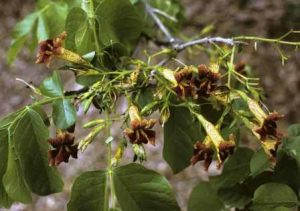
Markhamia zanzibarica. Photo:D.C.H. Plowes. Source: Flora of Zimbabwe
Sunday 6th December saw us taking the Harare Road to visit N’tabazinduna Lodge situated on a historic hill near Bulawayo. There was a good turn out on a pleasant sunny morning and a long line of cars snaked its way up the steep hill (fortunately the road had been well built over the steepest parts) to find quite a surprise at the top. An attractive safari camp has been constructed with clear views over the surrounding country and a steep drop immediately in front (had Mzilikazi thrown the bodies over right there). At the bottom of the hill was a water hole where the animals can drink and be fed while those above can sit with their sundowners and watch.
We were greeted by our host Peter Parsons who invited us to go wherever we wished in the area and in return all he asked was identification of the trees on the property. After identifying the trees in the immediate area, which included Albizia amara, Azanza garckeana and Combretum molle, we wandered off in various directions, some keeping to the top of the hill and others exploring lower down. We were surprised to find the most common tree on the hill was Ormocarpum trichocarpum in varying sizes up to 3+ metres tall. Another frequent find was Bolusanthus speciosus. We scrambled down the hill hoping to find some different species and maybe some animals. We passed a Pseudolachnostylis maprouneifolia and Ozoroa insignis, found lots of spoor but only saw some squirrels! We met back at the main building where we had tea (very welcome after climbing back up the hill) on the verandah watching the yellow-eyed canaries in the trees. We were given a brief and very interesting insight by Geoff Archer into the history of the events leading up to the massacre by Mzilikazi and Peter Parsons added some interesting details. The tree count amounted to seventy-eight species which included in addition to those mentioned above seven species of Acacia. Albizia antunesiana, Cissus coriifolia, Combretum apiculatum and hereroense, Commiphora africana, C.mollis and C.schimperi, Cussonia arborea and natalensis, Diplorhynchus condylocarpon, Markhamia zanzibarica and Zanthoxylum chalibeum.
Peter Parsons’ daughter who with her husband runs the Lodge gave us some details of their operation and we were pleased to hear that if they have no safari bookings, local residents can stay there for a modest fee, taking their own food and drinks and making use of the Lodge staff.
This was a most enjoyable outing and we are very grateful to Peter and his family for their hospitality.
-GILL SHORT
NYARUPINDA CATCHMENT January 1993
The Scene: On January 10th 1993 the rainfall for the season totaled 303mm. Streams are flowing into the Nyarupinda dam which we can now see again from the house. Planting rains came during the latter half of December, this made the countryside vibrant with activity. At dusk, from the streams, vleis and dam come the ‘once heard never forgotten‘ sounds of Bull Frogs, Common Toads, the piping call of little sucker footed Painted Reed Frogs, the trills and staccato ‘Bloip bloip’ of Running Frogs, now and then a solitary message from a Pearl Spotted Owl. There remains a sound, not yet identified at “Tinto”, a repeated short ascending hummed phrase made by one and sometimes several of whatever they are. It is heard during the night in the rainy season, Could the makers of this soft music be Frogs?
Mainly about Insects
Since early December 1992 the evil smelling flowers of Protea gaguedi have been watched to detect what pollinates them. There are three Protea patches within easy walking distance of the house. These have been visited at all times of day -until it is too dark to see. Pollinator possibilities for PROTEACIEAE are as follows: wind, birds, rodents, butterflies and moths, bees and wasps, flies, beetles, mites, others may be plant bugs (like Stink) and bats. Some of the visitors are diurnal and some nocturnal. The attraction is pollen, nectar, waxy or gummy substances and the Protea’s fleshy floral parts. Some visitors attract others eg insects are taken by birds. Some, according to the Protea Atlas Manual, hitch rides on each other from inflorescence to another. The inflorescences offer shelter, a refuge and extra warmth amongst the woolly fruits in the centre of the flower head. This is where some visitors will be found but they may not be pollinators. The qualification for a pollinator is that it has pollen on its head or body.
To make a list of the pollinators is no easy task, there are,’ several reasons for this : I
The pollen of Protea gaguedi is not as easily seen as for example that of the daisy family ASTERACEAE so it is difficult to detect it on potential pollinators,
Some visitors depart before they can be seen at close quarters.
The inaccessibility to the observer of all but the lowest blooms made it necessary to hook: down the tall ones which caused a disturbance
The small number of flowering trees on each site reduced the number of florets ready for pollination which limited the opportunities for seeing and identifying visitors.
On each site there were no very young Protea plants – regeneration was poor – this situation could result from a variety of causes one of which could be the absence of effective pollinators and consequently few viable seeds.
What encouraged us to keep searching was the long flowering period which included a variety of weather conditions. No doubt the pollinators select the right time to sip nectar and feed. Another aspect was that the rains are accompanied by intense insect activity – surely there would be visitors with pollen on them.
Things were not at all as we expected, it was the exception rather than the rule – to see something on a Protea tree or its blooms.
Our score was as follows :
- One Scarlet chested Sunbird – not feeding
- One bird perched and departed
- 5pm — 6pm was the time to see the most honey -bees.
- Non-spectacular butterflies, occasionally
- one small brown moth
- many small yellowish-brown beetles with three black dots on thorax, called Tephraea dichroa
- Some larger colourful beetles called Pachnoda depressa which were also seen in the garden on the flowers of Monets engleri
- A dark brown beetle (dug into the centre of an inflorescence) whose body language said “do not disturb me”
- One small glossy black beetle 1 cm in length which had 8 – 10 white spots like enamel paint.
This is the state of play so far.
The beetle Pachnoda degressa belongs to a sub-family of the large family or Scarab beetles, this sub family is popularly known as that of Sir Tony Neigh spelt Certoniinae in the text books on entomology.
This search has proved that some equipment is needed in order to detect pollinators of Protea Protea gaguedi and other tree Proteas and Faurea spp too.
Requirements : One ‘bearer’ to carry bird and insect field guides, the step ladder, food and liquid refreshment a foam plastic cushion and a longlife torch. You will need a have:-sack for notebook, pencils, pen knife (pencils always break), IOX lens, barrier cream, raincoat, high powered field glasses and expensive camera. Our equipment was a dog lead and field glasses. You will need to be very patient, oblivious of the passage of time, have absolutely no sense of urgency and be blessed with good luck. Another thing we noticed about Protea trees is that their habit of forked branching offers a nesting place for bird.
During 1993 Nysrupinda Catchment will not be a regular feature in “Tree Life”.
-Benedicta Graves
NEW PUBLICATIONS ON INDIGENOUS SPECIES
A handbook has recently been produced by the Department of Research and Specialist Services: A Guide to Growing Selected Indigenous woody Plants from Seed (Technical Handbook No. 8 by Malcolm Leppard and Stephen Duri, 89 pp; from Information Services, DR & SS, Harare $5). This gives much practical information on raising plants from seed in general, and specific details on 73 species, many of them with colourful flowers or of particular interest for cultivation. Specific details include flowering and fruiting behaviour, node of dispersal, details of fruits, tips on seed collection, cleaning, pre-treatment, sowing techniques, germination percentages, pests, growth rates, seed longevity and storage , and plant wage. These details are based on practical experience from Zimbabwe. The majority of the species, over 40, are forest species found in the Eastern Highlands, and germination of these seeds is not normally a problem as they generally do not have a dormancy requirement. Most or the 9 riverine species do not appear to require any pre-treatment. Over 20 species, however are from the seasonally-dry woodland or savanna parts of the country, where seed dormancy is a defence against germination with the first good rains and subsequently dying in a long dry spell. Seed dormancy also prevents the tree “putting all its eggs in the same basket”, ensures germination over several seasons, and allows seed to remain buried in the for many years. It is these species which often cause the most difficulties in germination and establishment, and for which this Handbook is most useful.
Complementary, in many ways, to this handbook is a small book called Seed Germination of Indigenous Trees in Botswana by Tabe Tietema, Eldbjorg Merkesdal and Jan Schroten (l06 pages) published by ACTS Press, Nairobi; available through the Biomass Users Network, Africa Regional Office, Private m 7768, Causeway, Harare, $17). This book covers similar ground for Botswana but has more technical introductory chapters covering factors determining germination of seeds, and practical aspects of seed collection, storage, germination and raising seedlings in a nursery. Sizty-two species are mentioned with vernacular names, distribution within Botswana and soil type. The germination treatments tried and results found are given along with recommended practices.
Many of the species mentioned here are also covered in the Zimbabwe book, and the results are not always similar! Which goes to show that there is still much to learn about raising our indigenous species, but there should now be no excuse for not trying.
-J. TIMBERLAKE
GEORGE HALL CHAIRMAN


